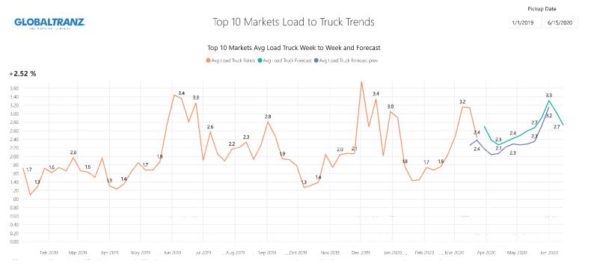
Globaltranz reports a mixed and volatile picture across the country
The full-service transportation and logistics provider GlobalTranz released an email to its customers regarding the North American market.
GlobalTranz is closely monitoring the COVID-19 situation and working with its customers to implement resilient strategies to weather the storm. The GlobalTranz cross-functional coronavirus Task Force is meeting daily and is in regular contact with all customers, employees, and office locations to ensure seamless continuity in their business operations.
Here is the latest information:
North America Market Update
LTL
• Carriers continue to be fully operational both over the road and in back-office support.
• Volumes have declined 10-15% over the prior week, driven primarily by reduced demand for
non-essentials. This is an opportune time for us to work with our customers and carriers on
pricing and capacity.
• As a growing number of businesses close, LTL carriers are increasingly challenged to store
undeliverable freight. Shipments in transit to closed consignees will be subject to rules tariff
charges.
Truckload
The truckload market presents a mixed and volatile picture, with varying conditions across many regions and lanes. The divide in the marketplace between “essential” and “non-essential” goods continues to play out. Month-end/quarter-end took a lot of freight off the docks which has not been replenished. Industry data suggests that manufacturing has met demand in some sectors of the economy.
• Load volumes have decreased 12% over the past 9 days since we saw volumes peak.
• This decrease offsets the 11% increase we saw in the 9 days prior to the volume peak.
• Outbound tender volumes, while still higher on a year-over-year comparison, are now falling.
Outbound Tender Rejections have declined 27% in the last 5 days.
• There has been a 25% week-over-week decline in truckload spot loads.
• Load to truck ratios have declined.
• Our load to truck forecast (the teal line in the graph below) indicates load to truck ratios will begin to rise in mid-April at levels that are elevated as compared to our pre-COVID-19 forecast.
 • “Panic buying” appears to have ended. Major retailers have reported reduced foot traffic, and consumer spending is being reported as being down roughly 30%.
• “Panic buying” appears to have ended. Major retailers have reported reduced foot traffic, and consumer spending is being reported as being down roughly 30%.
• As a result, some shippers are pulling back replenishment orders and recalibrating their shipping needs on a go-forward basis.
• As shoppers stay home, e-commerce orders for essential goods, including grocery items, have surged.
• This has freed up available truckload capacity which has shifted to the transportation of essential goods, contributing to the decline in rates.
• Meanwhile, in the southeast we are seeing increased tightness in capacity as the produce
season gets underway.
• More carriers are facing COVID-19 related issues, with increasing numbers of drivers either experiencing illness or staying home in order to avoid illness.
IMDL
• There has been a 14.4% annual decline in intermodal truck-rail loads on railroads in North America in the week ending March 28, according to the Association of American Railroads.
• Total movements for the five railroads serving the West Coast ports remained steady for a fifth consecutive week, leading some analysts to suggest that Asia-North America trade has bottomed.
Cross-Border
• TL and flatbed capacity are plentiful.
• The Mexican government declared a national public health emergency due to the COVID-19 pandemic, suspending non-essential activity until April 30th. This heavily affects cross-border
volumes between the US and Mexico. Only factories or facilities producing and distributing medical supplies or food among other essential items are exempt.
• Due to reduced volumes, Mexican Customs SAT (Tax Administrative Service) and the U.S.
Customs and Border Patrol announced they will shut down cargo processing at the Nogales, AZ border for the next three Sundays in April, with the potential for more Sunday closures in the
future.
Ports
• China’s manufacturing rebounded in March as authorities relaxed anti-COVID-19 controls and
allowed factories to reopen.
• We expect to see an influx of cargo to West Coast ports throughout the month of April, however, questions remain as to whether consignees will be able to receive the goods, as many businesses remain closed. This could lead to a shortage in storage and warehouse space in the region adjacent to the ports.
Outlook
• Truckload volumes and rates are trending to return to seasonal normalcy.
• We continue to monitor port and produce activity, as these represent upcoming sources of potential market tightening.
Recommendations for Shippers
• As the initial volume peak has subsided, now is the time to pivot from a reactionary to a more proactive mode. In our previous update, we encouraged shippers to prioritize, communicate,
and plan in partnership with their transportation providers. These guidelines are just as important today as they were last week.
• The COVID-19 pandemic has only exacerbated supply chain issues which became apparent during the China and Mexico trade disputes. GlobalTranz is assisting shippers with forward
planning and supply chain design. Please contact us for assistance.
• On Friday, March 27, 2020, the U.S. Congress passed, and President Trump signed into law, the Coronavirus Aid, Recovery, and Economic Security Act (“CARES Act”), the Federal government’s
stimulus program in response to the COVID-19 pandemic. Small businesses may be eligible to receive some relief in the form of low-interest, and in some cases, forgivable loans as part of the
CARES Act.









